Influence of WO3-Based Antireflection Coatings on Current Density in Silicon Heterojunction Solar Cells
Abstract
1. Introduction
2. Materials and Methods
2.1. Minimization of the Reflectance Using a Simulation with a WO3/ITO/Si Substrate Structure
2.2. WO3 Deposition on an SHJ Solar Cell
3. Results
3.1. Simulation Results with a WO3/ITO/Si Substrate Structure Using an OPAL 2 Simulator
3.2. Experimental Results of WO3 Deposition on SHJ Solar Cells
4. Conclusions
Author Contributions
Funding
Institutional Review Board Statement
Informed Consent Statement
Data Availability Statement
Conflicts of Interest
References
- Yoshikawa, K.; Kawasaki, H.; Yoshida, W.; Irie, T.; Konishi, K.; Nakano, K.; Uto, T.; Adachi, D.; Kanematsu, M.; Uzu, H. Silicon heterojunction solar cell with interdigitated back contacts for a photoconversion efficiency over 26%. Nat. Energy 2017, 2, 17032. [Google Scholar] [CrossRef]
- Benick, J.; Richter, A.; Müller, R.; Hauser, H.; Feldmann, F.; Krenckel, P.; Riepe, S.; Schindler, F.; Schubert, M.C.; Hermle, M. High-efficiency n-type HP mc silicon solar cells. IEEE J. Photovolt. 2017, 7, 1171–1175. [Google Scholar] [CrossRef]
- Zhao, J.; Wang, A.; Green, M.A.; Ferrazza, F. 19.8% efficient “honeycomb” textured multicrystalline and 24.4% monocrystalline silicon solar cells. Appl. Phys. Lett. 1998, 73, 1991–1993. [Google Scholar] [CrossRef]
- Richter, A.; Benick, J.; Feldmann, F.; Fell, A.; Hermle, M.; Glunz, S.W. n-Type Si solar cells with passivating electron contact: Identifying sources for efficiency limitations by wafer thickness and resistivity variation. Sol. Energy Mater. Sol. Cells 2017, 173, 96–105. [Google Scholar] [CrossRef]
- Moslehi, M.; Kapur, P.; Kramer, J.; Rana, V.; Seutter, S.; Deshpande, A.; Stalcup, T.; Kommera, S.; Ashjaee, J.; Calcaterra, A. World-record 20.6% efficiency 156 mm × 156 mm full-square solar cells using low-cost kerfless ultrathin epitaxial silicon & porous silicon lift-off technology for industry-leading high-performance smart PV modules. In Proceedings of the PV Asia Pacific Conference (APVIA/PVAP), Singapore, 22–24 October 2012. [Google Scholar]
- Keevers, M.J.; Young, T.L.; Schubert, U.; Green, M.A. 10% efficient CSG minimodules. In Proceedings of the 22nd European Photovoltaic Solar Energy Conference, Milan, Italy, 3–7 September 2007; pp. 1783–1790. [Google Scholar]
- Park, S.; Park, H.; Kim, D.; Yang, J.; Lee, D.; Kim, Y.-S.; Kim, H.-J.; Suh, D.; Min, B.K.; Kim, K.N. Optimization of controllable factors in the aluminum silicon eutectic paste and rear silicon nitride mono-passivation layer of PERC solar cells. Met. Mater. Int. 2018, 24, 664–671. [Google Scholar] [CrossRef]
- Chapin, D.M.; Fuller, C.S.; Pearson, G.L. A new silicon p-n junction photocell for converting solar radiation into electrical power. J. Appl. Phys. 1954, 25, 676–677. [Google Scholar] [CrossRef]
- Wang, M.; Wang, H.; Li, W.; Hu, X.; Sun, K.; Zang, Z. Defect passivation using ultrathin PTAA layers for efficient and stable perovskite solar cells with a high fill factor and eliminated hysteresis. J. Mater. Chem. A 2019, 7, 26421–26428. [Google Scholar] [CrossRef]
- Torkaman, N.; Ganjkhanlou, Y.; Kazemzad, M.; Dabaghi, H.; Keyanpour-Rad, M. Crystallographic parameters and electro-optical constants in ITO thin films. Mater. Charact. 2010, 61, 362–370. [Google Scholar] [CrossRef]
- Luan, Y.; Wang, F.; Zhuang, J.; Lin, T.; Wei, Y.; Chen, N.; Zhang, Y.; Wang, F.; Yu, P.; Mao, L.; et al. Dual-function interface engineering for efficient perovskite solar cells. EcoMat 2021, 3, e12092. [Google Scholar] [CrossRef]
- Wang, S.; Wu, T.; Qiu, J.; Wang, R.; Zhu, Z.; Zhang, X.; Hua, Y. Enhanced electron transfer dynamics in perylene diimide passivated efficient and stable perovskite solar cells. EcoMat 2021, 3, e12146. [Google Scholar] [CrossRef]
- Zhu, C.-T.; Yang, Y.; Lin, F.-Y.; Luo, Y.; Ma, S.-P.; Zhu, L.; Guo, X.-Y. Electrodeposited transparent PEDOT for inverted perovskite solar cells: Improved charge transport and catalytic performances. Rare Met. 2021, 40, 2402–2414. [Google Scholar] [CrossRef]
- Miao, Y.; Wang, X.; Zhang, H.; Zhang, T.; Wei, N.; Liu, X.; Chen, Y.; Chen, J.; Zhao, Y. In situ growth of ultra-thin perovskitoid layer to stabilize and passivate MAPbI3 for efficient and stable photovoltaics. eScience 2021, 1, 91–97. [Google Scholar] [CrossRef]
- Li, S.; Cao, Y.-L.; Li, W.-H.; Bo, Z.-S. A brief review of hole transporting materials commonly used in perovskite solar cells. Rare Met. 2021, 40, 2712–2729. [Google Scholar] [CrossRef]
- Green, M.A. The passivated emitter and rear cell (PERC): From conception to mass production. Sol. Energy Mater. Sol. Cells 2015, 143, 190–197. [Google Scholar] [CrossRef]
- Blakers, A.W.; Wang, A.; Milne, A.M.; Zhao, J.; Green, M.A. 22.8% efficient silicon solar cell. Appl. Phys. Lett. 1989, 55, 1363–1365. [Google Scholar] [CrossRef]
- Masuko, K.; Shigematsu, M.; Hashiguchi, T.; Fujishima, D.; Kai, M.; Yoshimura, N.; Yamaguchi, T.; Ichihashi, Y.; Mishima, T.; Matsubara, N. Achievement of more than 25% conversion efficiency with crystalline silicon heterojunction solar cell. IEEE J. Photovolt. 2014, 4, 1433–1435. [Google Scholar] [CrossRef]
- Moldovan, A.; Feldmann, F.; Kaufmann, K.; Richter, S.; Werner, M.; Hagendorf, C.; Zimmer, M.; Rentsch, J.; Hermle, M. Tunnel oxide passivated carrier-selective contacts based on ultra-thin SiO2 layers grown by photo-oxidation or wet-chemical oxidation in ozonized water. In Proceedings of the 2015 IEEE 42nd Photovoltaic Specialist Conference (PVSC), New Orleans, LO, USA, 14–19 June 2015; pp. 1–6. [Google Scholar]
- Hussain, S.Q.; Kim, S.; Ahn, S.; Park, H.; Le, A.H.T.; Lee, S.; Lee, Y.; Lee, J.H.; Yi, J. RF magnetron sputtered ITO: Zr thin films for the high efficiency a-Si: H/c-Si heterojunction solar cells. Met. Mater. Int. 2014, 20, 565–569. [Google Scholar] [CrossRef]
- Kim, S.; Balaji, P.; Augusto, A.; Bowden, S.; Honsberg, C.B. In Ultra thin Al2O3 passivation for het-ero-junction Si solar cell. In Proceedings of the 2019 IEEE 46th Photovoltaic Specialists Conference (PVSC), Chicago, IL, USA, 16–21 June 2019. [Google Scholar]
- Ahn, J.; Chou, H.; Banerjee, S.K. Graphene-Al2O3-silicon heterojunction solar cells on flexible silicon substrates. J. Appl. Phys. 2017, 121, 163105. [Google Scholar] [CrossRef]
- Kato, S.; Kurokawa, Y.; Gotoh, K.; Soga, T. Silicon Nanowire Heterojunction Solar Cells with an Al2O3 Passivation Film Fabricated by Atomic Layer Deposition. Nanoscale Res. Lett. 2019, 14, 99. [Google Scholar] [CrossRef]
- Lee, D.W.; Bhopal, M.F.; Lee, S.H.; Lee, A.R.; Kim, H.J.; Rehman, M.A.; Seo, Y.; Lim, K.J.; Shin, W.S.; Lee, S.H. Effect of additional HfO 2 layer deposition on heterojunction c-Si solar cells. Energy Sci. Eng. 2018, 6, 706–715. [Google Scholar] [CrossRef]
- Lee, A.R.; Lee, D.W.; Lee, S.H.; Bhopal, M.F.; Kim, H.J.; Lim, K.-J.; Shin, W.-S.; Lee, S.H.; Kim, J. Study of Double Layer Indium Tin Oxide in Silicon Hetero-Junction Solar Cells. J. Nanosci. Nanotechnol. 2020, 20, 161–167. [Google Scholar] [CrossRef] [PubMed]
- Cruz, A.; Erfurt, D.; Wagner, P.; Morales-Vilches, A.B.; Ruske, F.; Schlatmann, R.; Stannowski, B. Optoelectrical analysis of TCO+ Silicon oxide double layers at the front and rear side of silicon heterojunction solar cells. Sol. Energy Mater. Sol. Cells 2022, 236, 111493. [Google Scholar] [CrossRef]
- Lee, D.; Kim, H.-D. Improvement in the energy conversion efficiency for silicon heterojunction solar cells due to SiOx inserted with conducting filaments. J. Alloys Compd. 2023, 932, 167669. [Google Scholar] [CrossRef]
- Liu, W.; Zhang, L.; Yang, X.; Shi, J.; Yan, L.; Xu, L.; Wu, Z.; Chen, R.; Peng, J.; Kang, J. Damp-heat-stable, high-efficiency, industrial-size silicon heterojunction solar cells. Joule 2020, 4, 913–927. [Google Scholar] [CrossRef]
- Wang, H.; Li, H.; Cai, W.; Zhang, P.; Cao, S.; Chen, Z.; Zang, Z. Challenges and strategies relating to device function layers and their integration toward high-performance inorganic perovskite solar cells. Nanoscale 2020, 12, 14369–14404. [Google Scholar] [CrossRef] [PubMed]
- Yuan, Z.; Wu, P.C.; Chen, Y.C. Optical Resonator Enhanced Photovoltaics and Photocatalysis: Fundamental and Recent Progress. Laser Photonics Rev. 2022, 16, 2100202. [Google Scholar] [CrossRef]
- McIntosh, K.R.; Baker-Finch, S.C. OPAL 2: Rapid optical simulation of silicon solar cells. In Proceedings of the 2012 38th IEEE Photovoltaic Specialists Conference, Austin, TX, USA, 3–8 June 2012; pp. 265–271. [Google Scholar] [CrossRef]
- Lee, D.; Lee, A.; Kim, H.-D. IZO/ITO Double-Layered Transparent Conductive Oxide for Silicon Heterojunction Solar Cells. IEEE Access 2022, 10, 77170–77175. [Google Scholar] [CrossRef]
- Zahid, M.A.; Khokhar, M.Q.; Park, S.; Hussain, S.Q.; Kim, Y.; Yi, J. Influence of Al2O3/IZO double-layer antireflective coating on the front side of rear emitter silicon heterojunction solar cell. Vacuum 2022, 200, 110967. [Google Scholar] [CrossRef]
- Lee, H.Y.; Yang, I.J.; Yoon, J.-H.; Jin, S.-H.; Kim, S.; Song, P.K. Thermoelectric Properties of Zinc-Doped Indium Tin Oxide Thin Films Prepared Using the Magnetron Co-Sputtering Method. Coatings 2019, 9, 788. [Google Scholar] [CrossRef]
- Scheul, T.E.; Khorani, E.; Rahman, T.; Charlton MD, B.; Boden, S.A. Wavelength and angle resolved reflectance measurements of pyramidal textures for crystalline silicon photovoltaics. Prog. Photovolt. Res. Appl. 2020, 28, 1248–1257. [Google Scholar] [CrossRef]
- Double Layer Anti Reflection Coatings. Available online: https://www.pveducation.org/pvcdrom/design-of-silicon-cells/double-layer-anti-reflection-coatings (accessed on 26 May 2022).
- Kang, S.W.; Lee, H.J.; Cho, S.H.; Cheong, W.S.; Lee, G.H.; Song, P.K. Effects of Sn concentration on ultrathin ITO films deposited using DC magnetron sputtering. J. Nanoelectron. Optoelectron. 2012, 7, 494–497. [Google Scholar] [CrossRef]
- Lee, D.W.; Rehman, A.; Lee, S. Characteristics of ITO film dependence upon substrate temperature using electron beam evaporator. Korean J. Met. Mater. 2015, 53, 729. [Google Scholar] [CrossRef]
- Gwamuri, J.; Vora, A.; Khanal, R.R.; Phillips, A.B.; Heben, M.J.; Guney, D.O.; Bergstrom, P.; Kulkarni, A.; Pearce, J.M. Limitations of ultra-thin transparent conducting oxides for integration into plasmonic-enhanced thin-film solar photovoltaic devices. Mater. Renew. Sustain. Energy 2015, 4, 12. [Google Scholar] [CrossRef]
- Tirca, I.; Boerasu, I.; Radu, M.-S.; Osiac, M. Refractive index of WO3 thin films grown under various temperatures determined by the Swanepoel method. Phys. B Condens. Matter 2021, 620, 413266. [Google Scholar] [CrossRef]
- Reference Air Mass 1.5 Spectra. Available online: https://www.nrel.gov/grid/solar-resource/spectra-am1.5.html (accessed on 26 May 2022).
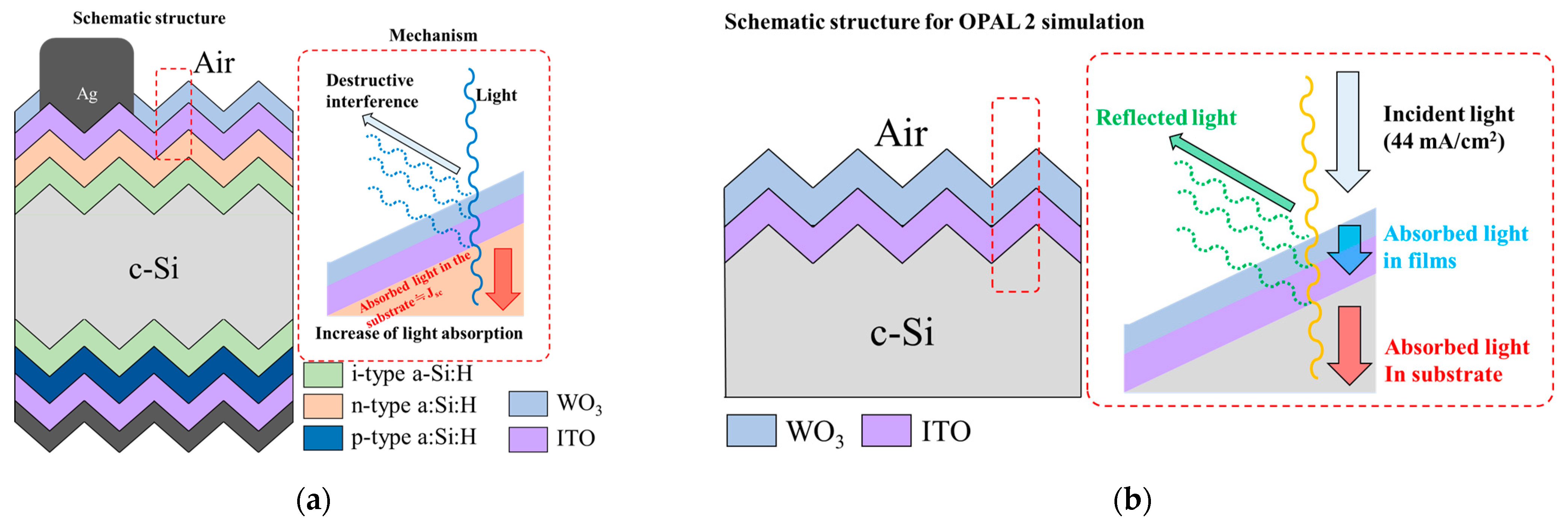
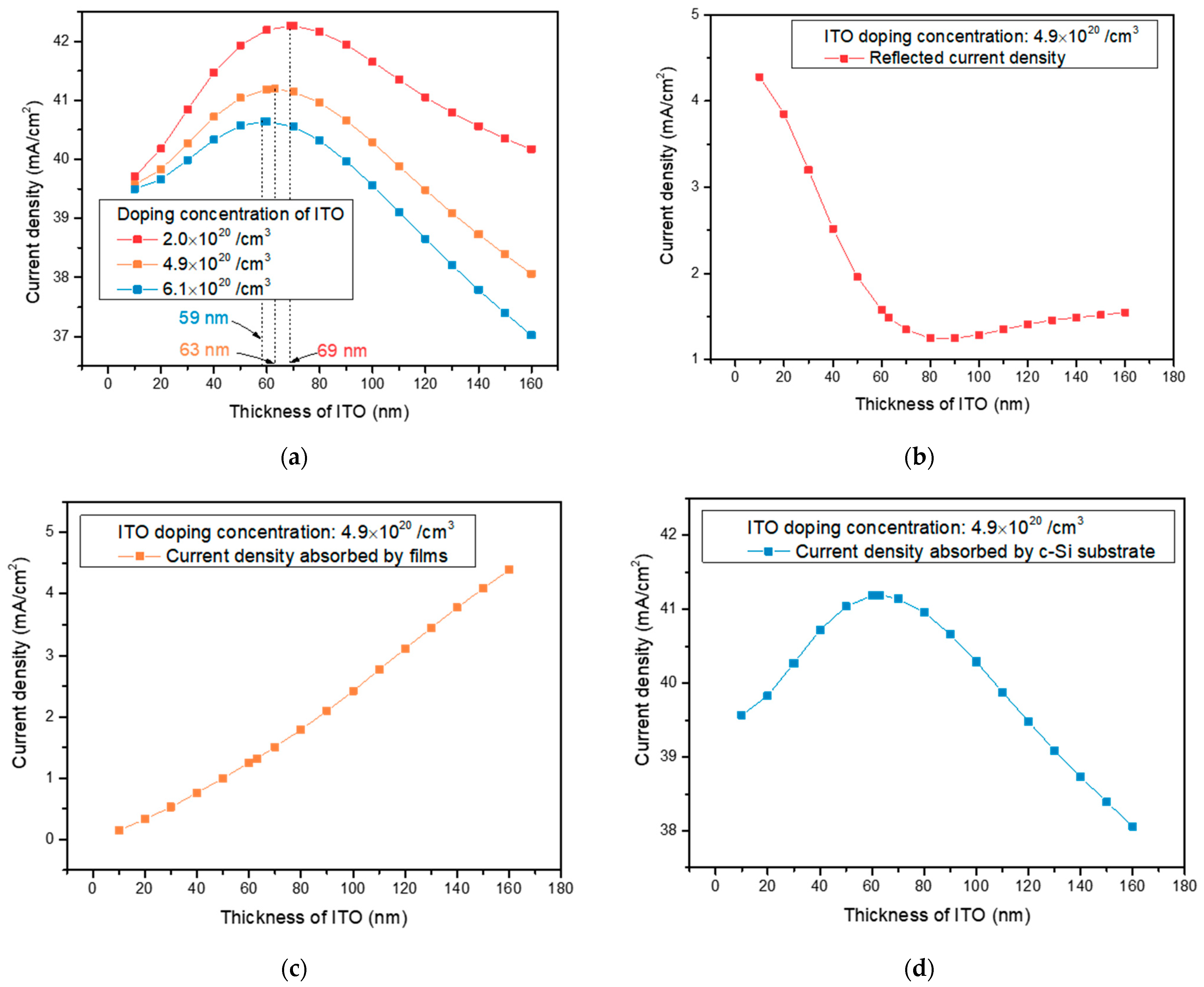

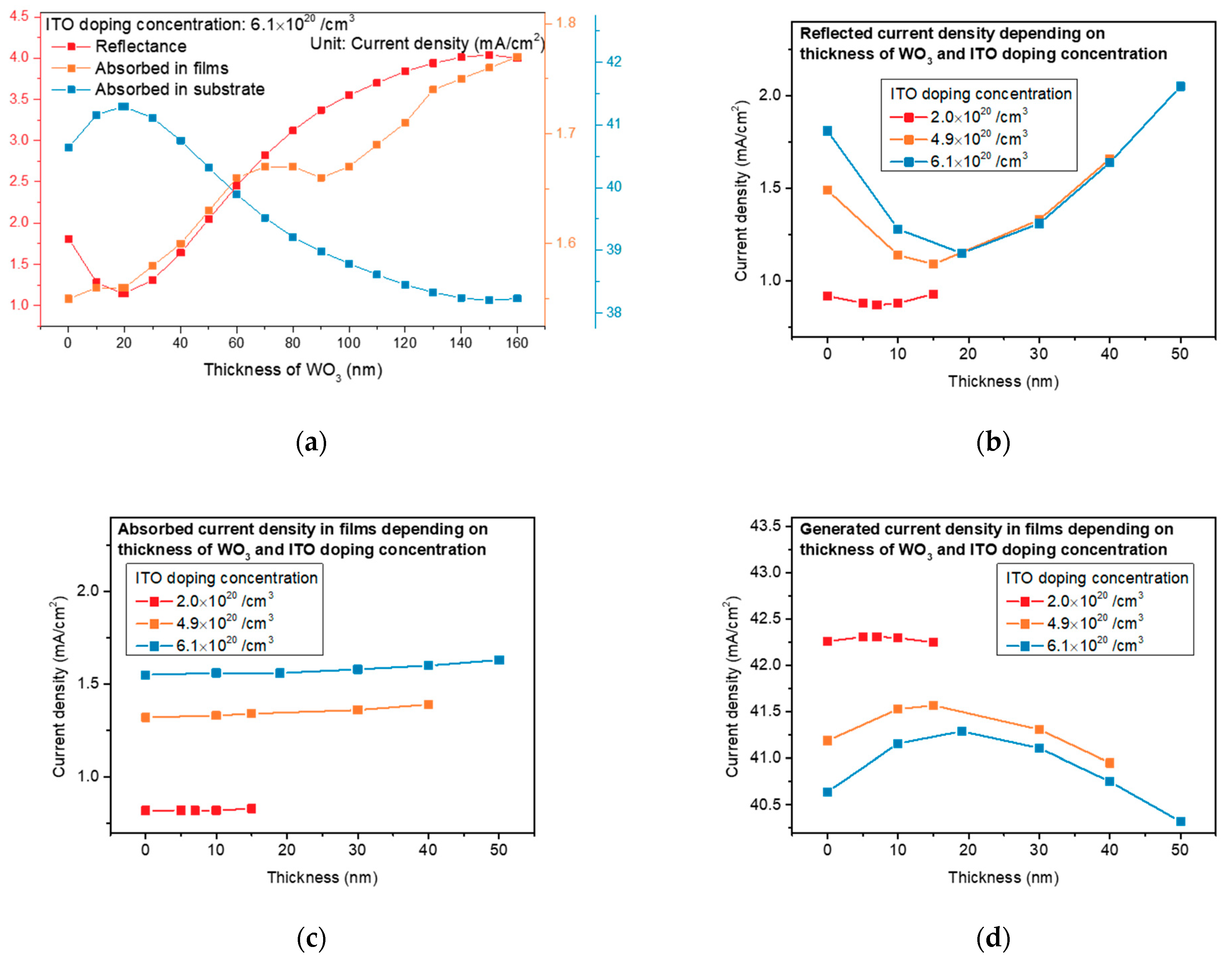
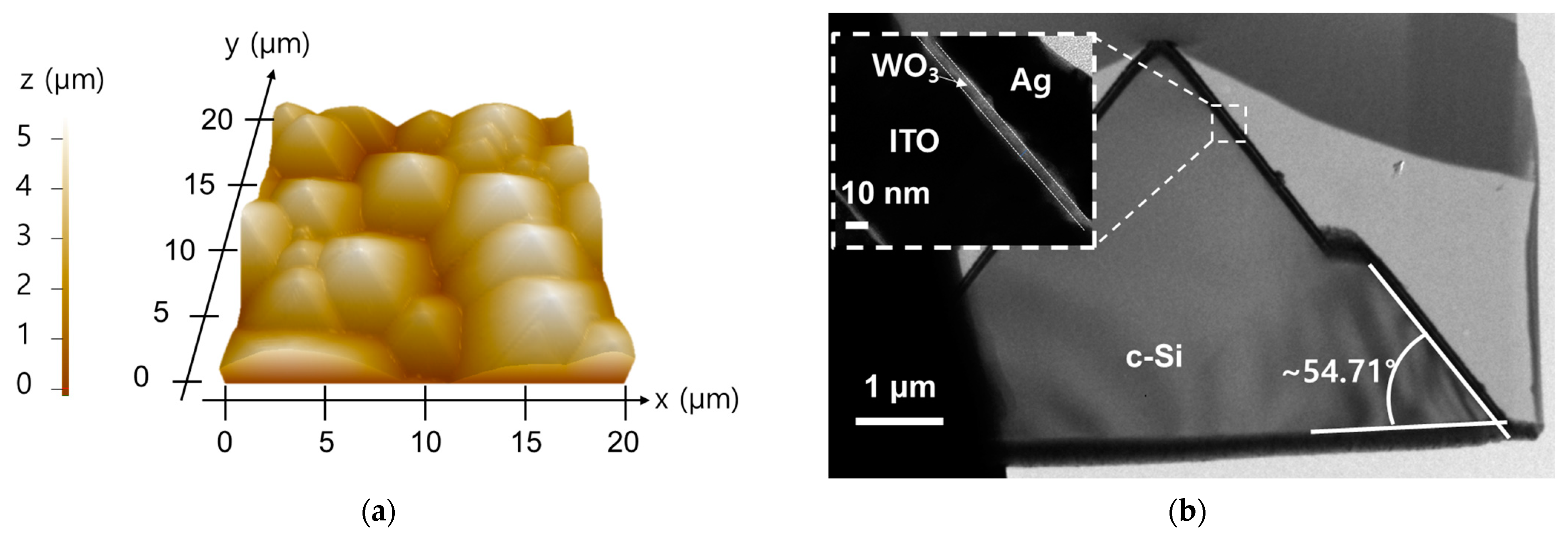
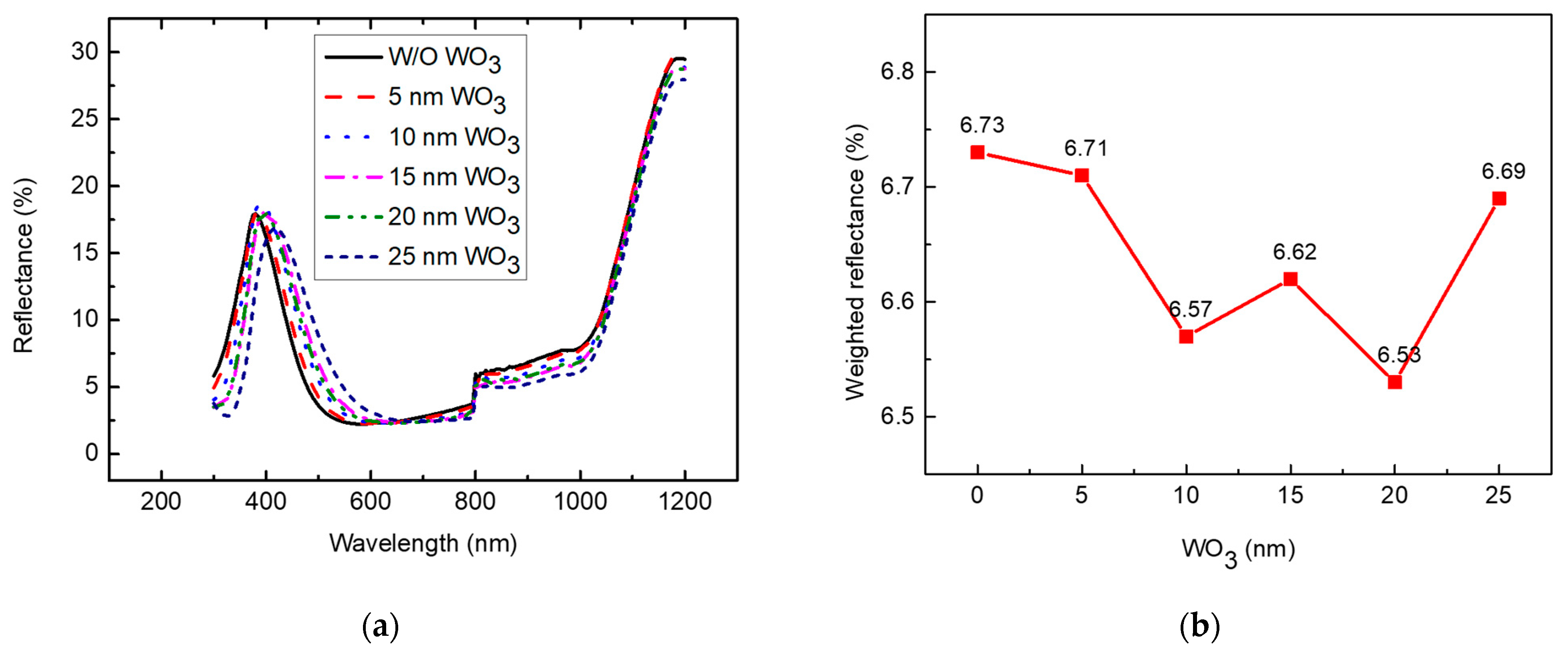
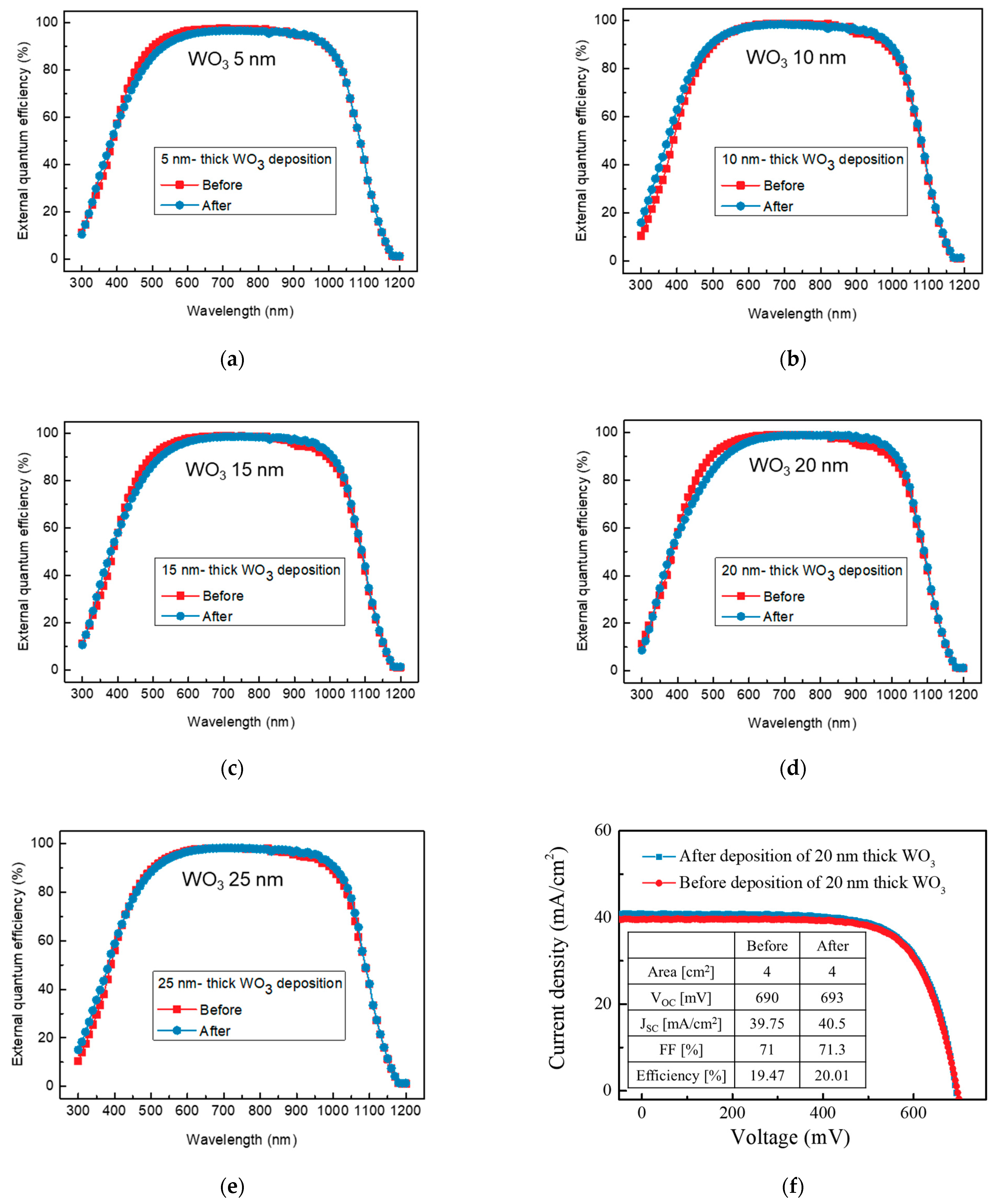
| Thickness (nm) | 5 | 10 | 15 | 20 | 25 | |||||
|---|---|---|---|---|---|---|---|---|---|---|
| Before | After | Before | After | Before | After | Before | After | Before | After | |
| Voc (mV) | 706 | 708 | 675 | 669 | 697 | 697 | 690 | 693 | 709 | 711 |
| Jsc (mA/cm2) | 39.63 | 40.07 | 39.84 | 40.07 | 40.40 | 40.28 | 39.75 | 40.50 | 39.86 | 40.08 |
| FF (%) | 75.2 | 75.9 | 69.9 | 67.4 | 73.1 | 72.2 | 71 | 71.3 | 76.2 | 77.3 |
| Efficiency (%) | 21.04 | 21.53 | 18.8 | 18.07 | 20.58 | 20.27 | 19.47 | 20.01 | 21.53 | 22.03 |
Disclaimer/Publisher’s Note: The statements, opinions and data contained in all publications are solely those of the individual author(s) and contributor(s) and not of MDPI and/or the editor(s). MDPI and/or the editor(s) disclaim responsibility for any injury to people or property resulting from any ideas, methods, instructions or products referred to in the content. |
© 2023 by the authors. Licensee MDPI, Basel, Switzerland. This article is an open access article distributed under the terms and conditions of the Creative Commons Attribution (CC BY) license (https://creativecommons.org/licenses/by/4.0/).
Share and Cite
Lee, D.; Chae, M.; Ahmad, I.; Kim, J.-R.; Kim, H.-D. Influence of WO3-Based Antireflection Coatings on Current Density in Silicon Heterojunction Solar Cells. Nanomaterials 2023, 13, 1550. https://doi.org/10.3390/nano13091550
Lee D, Chae M, Ahmad I, Kim J-R, Kim H-D. Influence of WO3-Based Antireflection Coatings on Current Density in Silicon Heterojunction Solar Cells. Nanomaterials. 2023; 13(9):1550. https://doi.org/10.3390/nano13091550
Chicago/Turabian StyleLee, Doowon, Myoungsu Chae, Ibtisam Ahmad, Jong-Ryeol Kim, and Hee-Dong Kim. 2023. "Influence of WO3-Based Antireflection Coatings on Current Density in Silicon Heterojunction Solar Cells" Nanomaterials 13, no. 9: 1550. https://doi.org/10.3390/nano13091550
APA StyleLee, D., Chae, M., Ahmad, I., Kim, J.-R., & Kim, H.-D. (2023). Influence of WO3-Based Antireflection Coatings on Current Density in Silicon Heterojunction Solar Cells. Nanomaterials, 13(9), 1550. https://doi.org/10.3390/nano13091550







